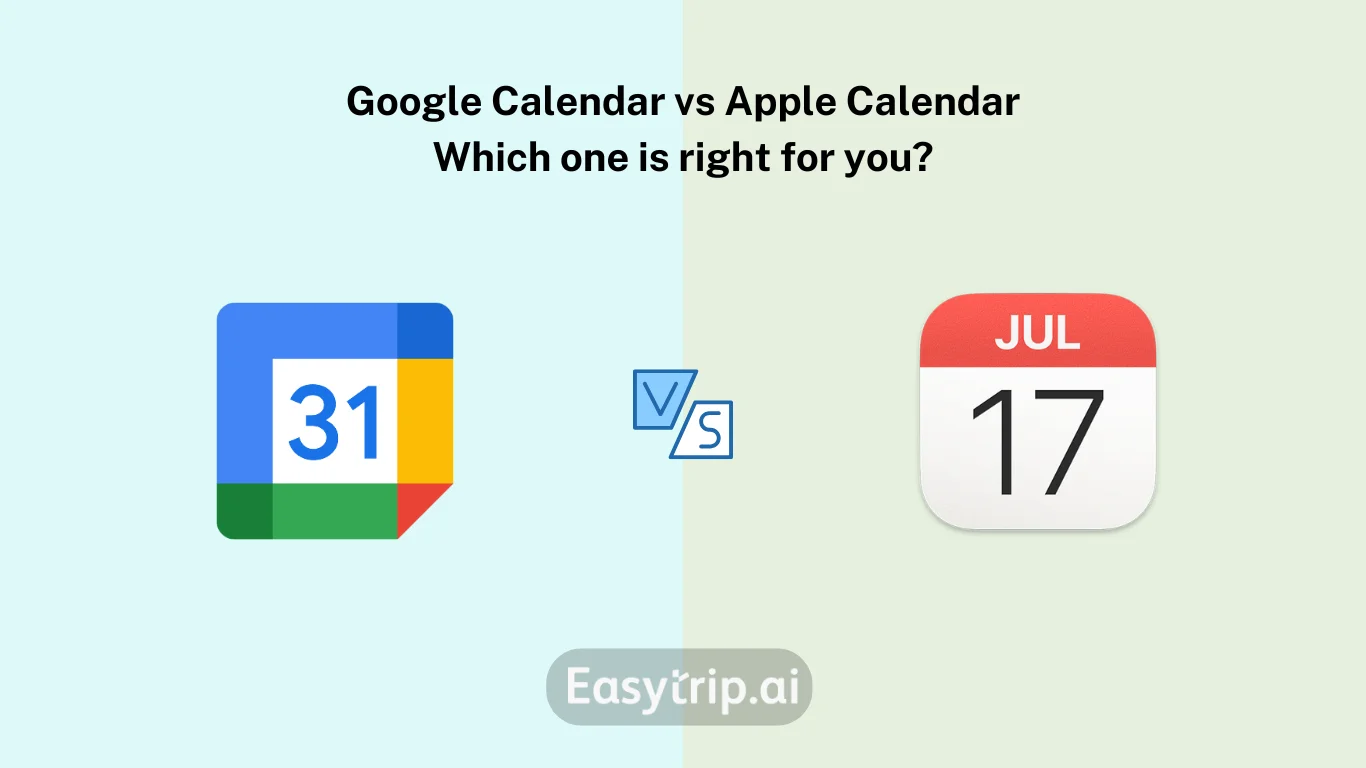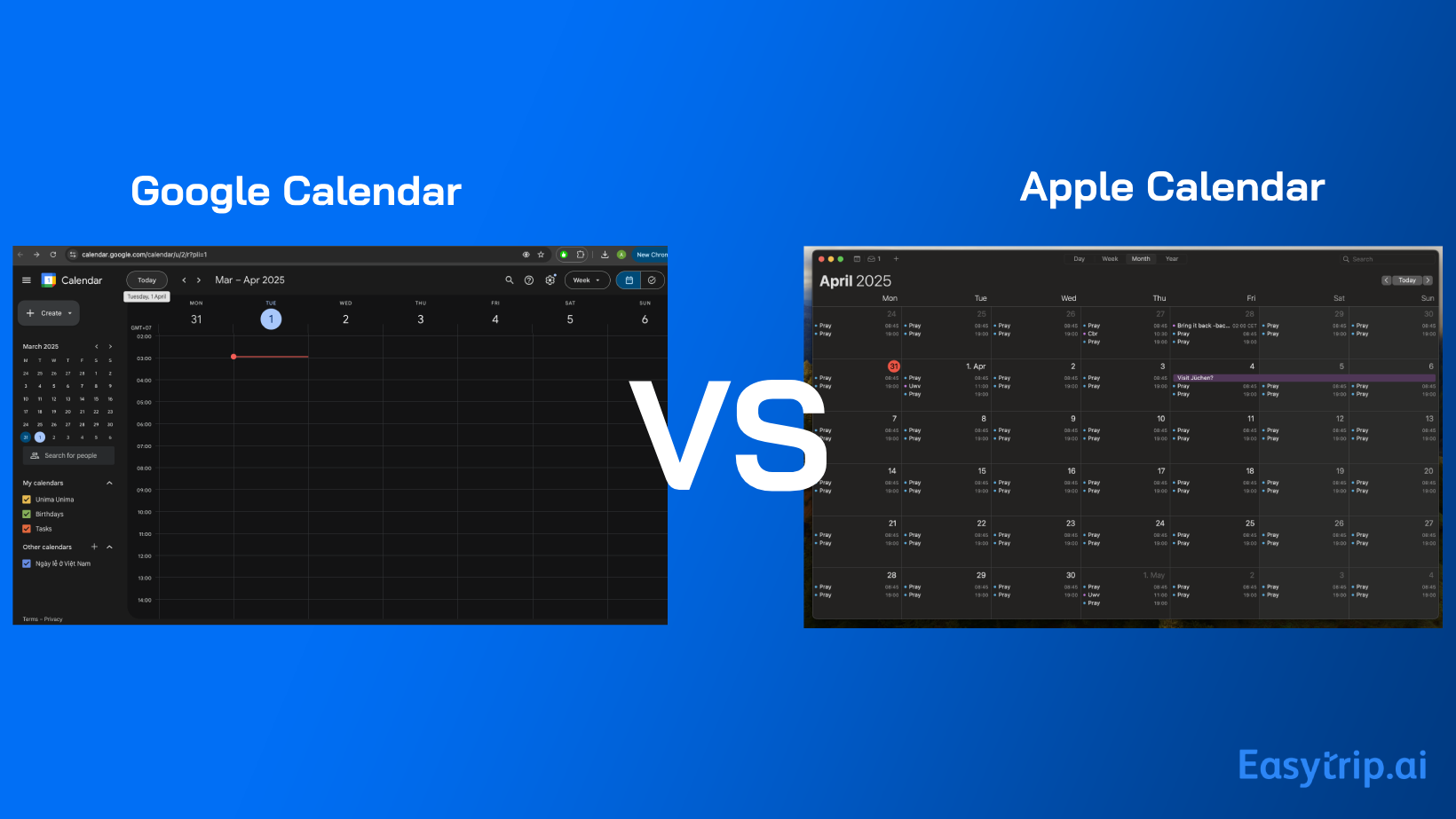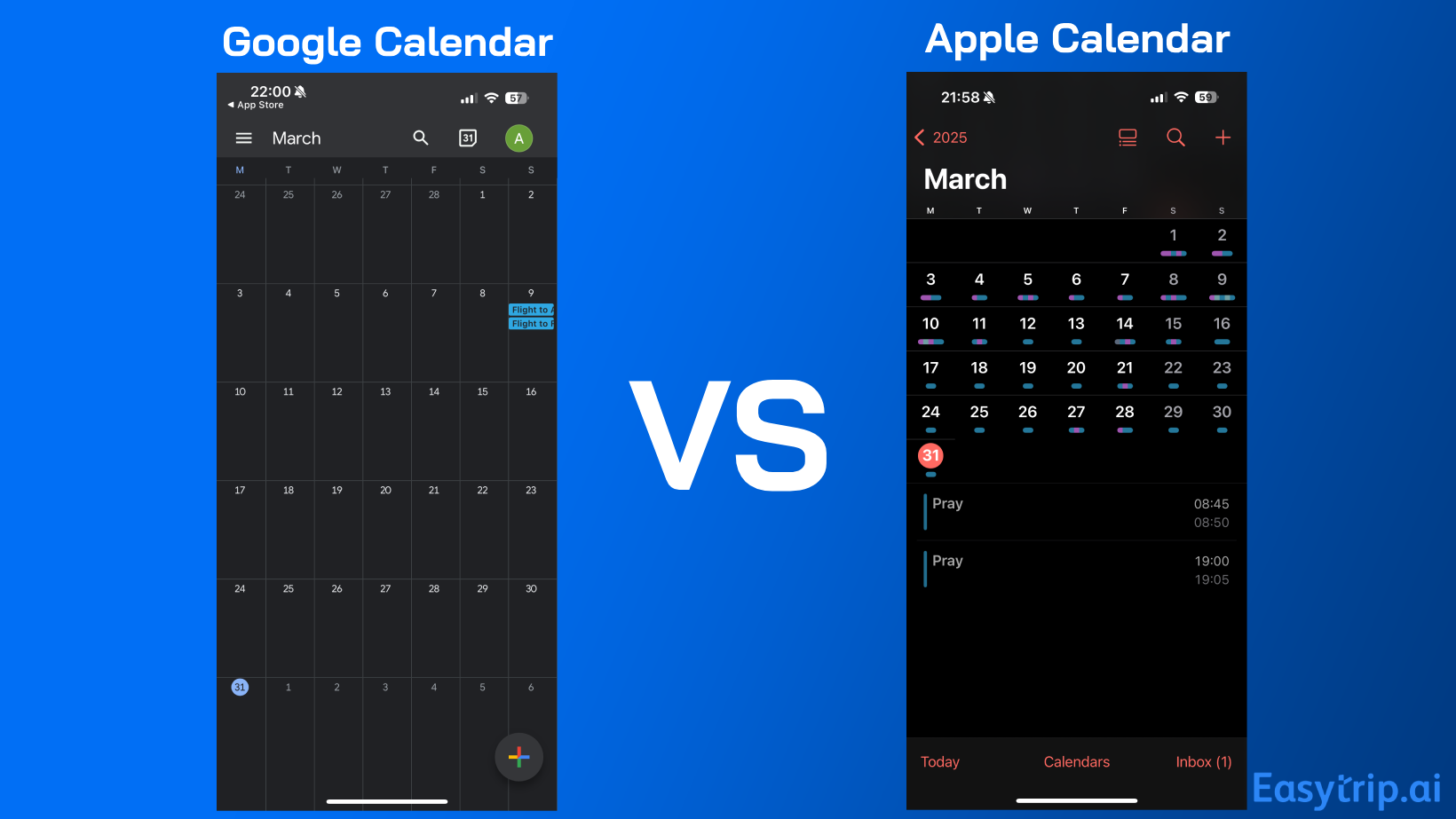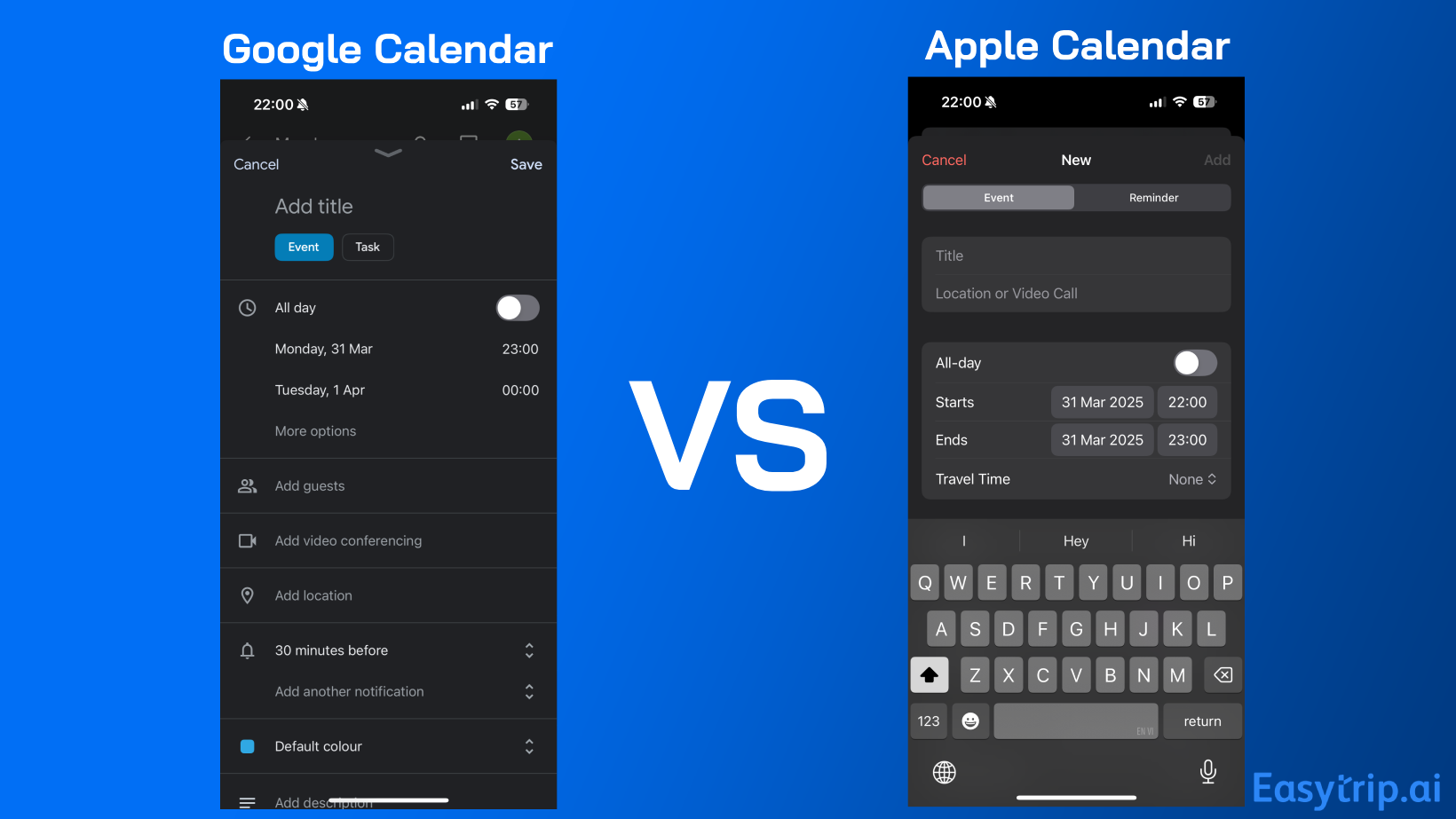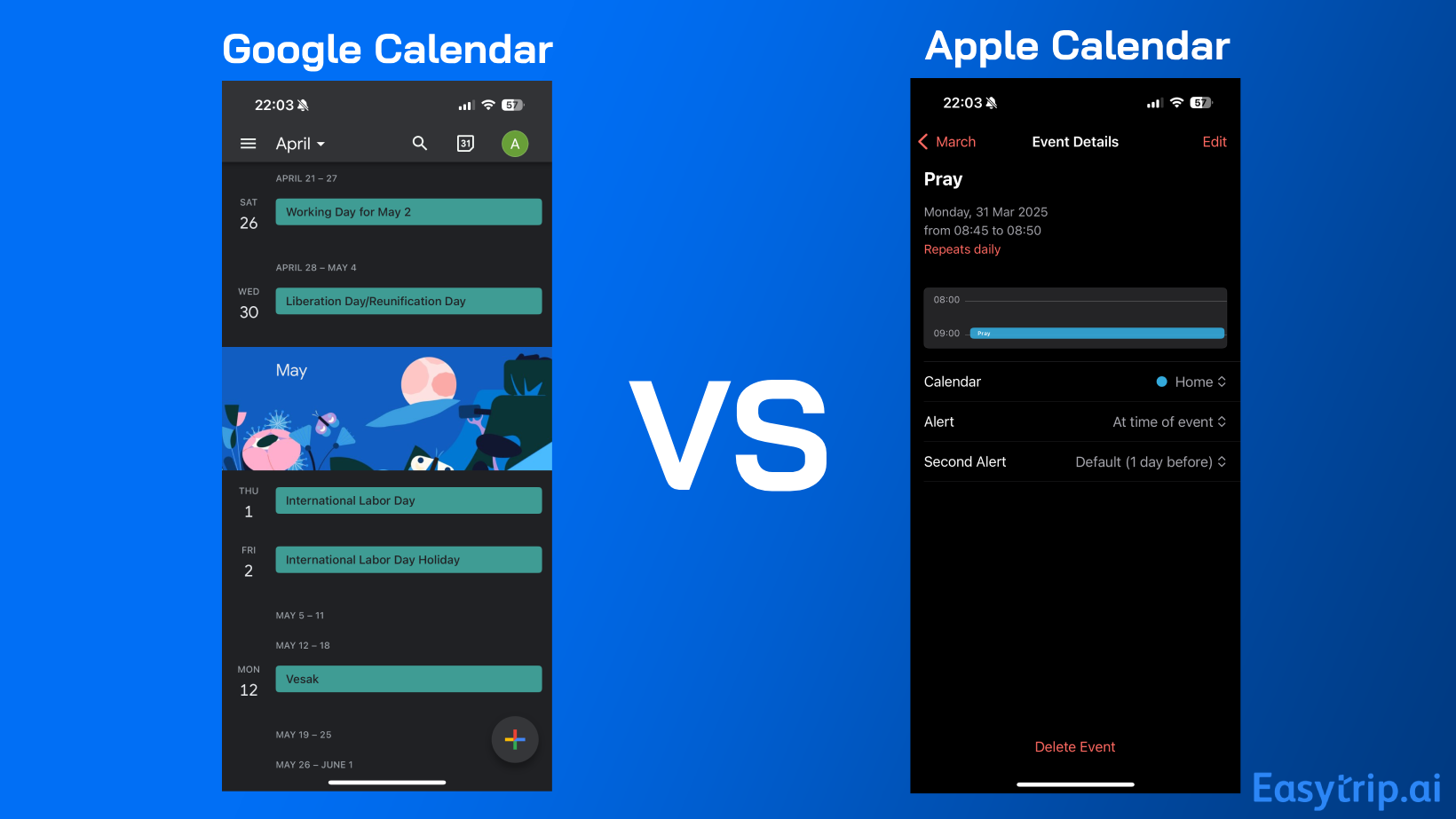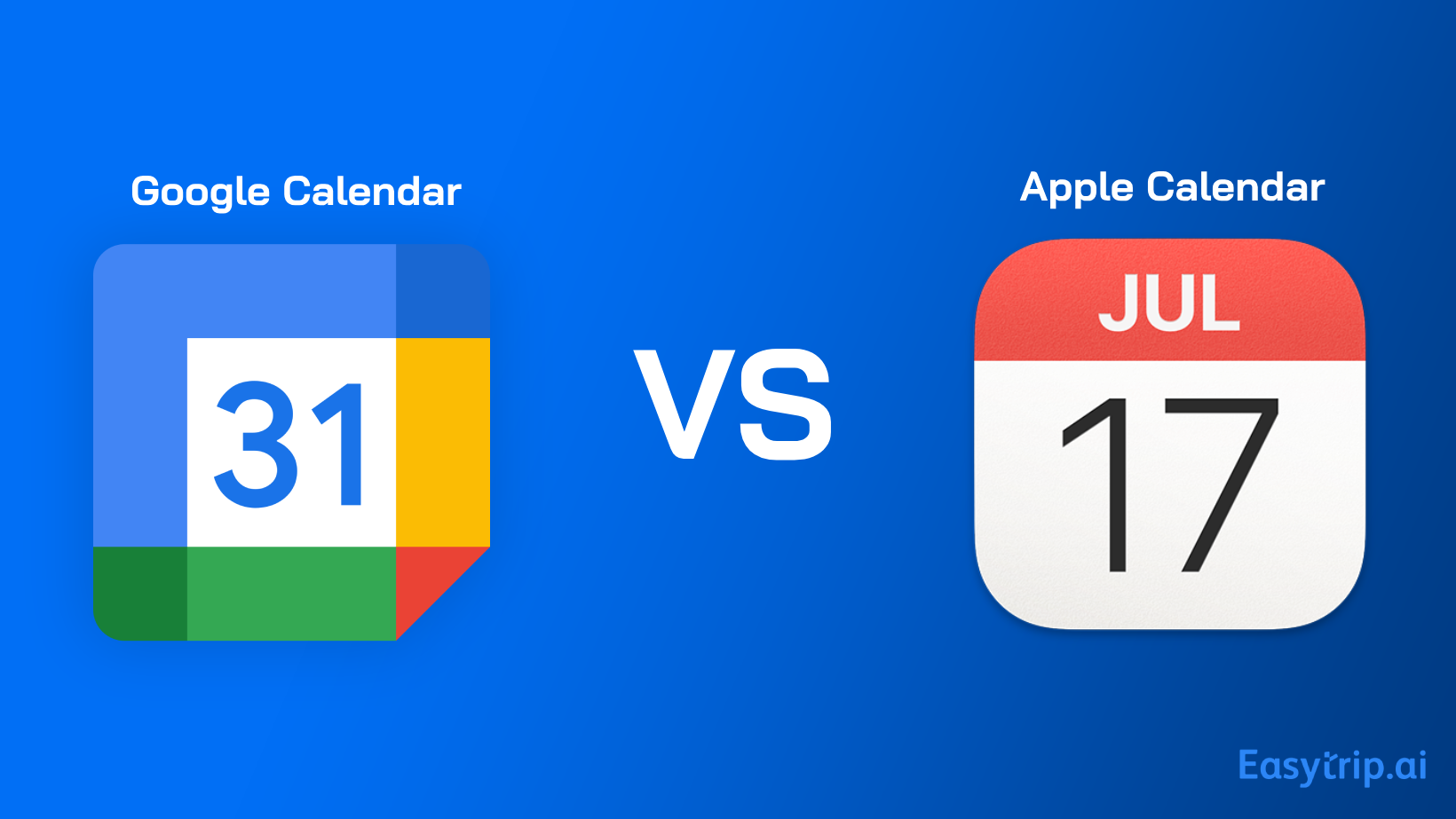As the digital landscape continues to evolve, the need for efficient time management tools is more critical than ever. Google Calendar vs Apple Calendar are two preeminent options, each boasting unique offerings tailored to distinct user preferences. Whether you prefer Google’s extensive platform compatibility and integration or Apple’s polished ecosystem, choosing the right calendar system can have profound impacts on your productivity and workflow. Let’s dive into comparing the distinctive features, integrations, and functionalities of these two powerhouses to help you determine which one best suits your needs when using Easytrip AI.
Overview of google calendar and apple calendar
Google Calendar and Apple Calendar serve as pivotal tools in the realm of digital organization, helping users streamline their schedules and optimize productivity. Google Calendar is celebrated for its wide-ranging compatibility across diverse devices, making it a favored choice for users who require flexible, cross-platform access. This tool excels in environments where multiple operating systems coexist, due to its robust integration with Google Workspace applications like Gmail and Google Meet.
Conversely, Apple Calendar offers a seamless experience within the Apple ecosystem, as it is deeply integrated with iOS and macOS. It provides exceptional synchronization across Apple devices via iCloud, ensuring that users’ calendars are always up to date. This calendar is an ideal choice for those who find comfort in Apple’s consistent design language and streamlined integration with native apps such as Siri and Reminders.
Google Calendar stands out for its collaboration features, enabling real-time updates and shared calendars, which are indispensable for team environments. It also promotes productivity with customizable notifications and event reminders that sync across all platforms. On the other hand, Apple Calendar prides itself on its simplicity and intuitive interface, prioritizing ease of use and a minimalist design that appeals to Apple enthusiasts who value clean aesthetics and operational smoothness.
The differences in design and functionality between these two tools directly reflect their target audiences. Google Calendar tends to suit users who prioritize versatility and extensive integrations, while Apple Calendar is preferable for those immersed in the Apple ecosystem who value a seamless user experience. By examining these aspects, potential users can better determine which calendar aligns more closely with their day-to-day requirements.
Platform compatibility
Both Google Calendar and Apple Calendar showcase strengths in platform compatibility, albeit in unique ways. Google Calendar’s cross-platform proficiency ensures accessibility across various devices, catering to users who oscillate between different operating systems. Meanwhile, Apple Calendar offers a harmonized experience through tight integration with Apple hardware, ideal for individuals invested in the iOS and macOS environment. These foundational distinctions shape their respective usability and integration into daily digital workflows.
Devices that support google calendar
Google Calendar shines in its ability to function seamlessly across numerous devices and operating systems, thereby appealing to a wide and diverse user base. Its compatibility includes a range of platforms, making it indispensable for users who require flexibility in their daily digital interactions.
- Android Devices: As a Google product, Google Calendar naturally integrates with Android smartphones and tablets. This integration allows Android users to manage their schedules and receive notifications directly on their mobile devices.
- iOS Devices: Google Calendar is accessible on iPhones and iPads, ensuring that even Apple device users can benefit from its extensive features. The app is available for download via the App Store, offering a user-friendly interface and full functionality.
- Windows and macOS: Desktop users can take advantage of Google Calendar through web browsers such as Chrome, Firefox, and Safari. This access ensures that your calendar is never out of reach, regardless of your desktop operating system.
- Smart Home Devices: Integration with Google Assistant and other smart home technologies allows users to oversee and manage their schedules using voice commands, providing an additional layer of convenience.
These device integrations underscore Google Calendar’s commitment to versatile, cross-platform utility, making it an attractive choice for those working within mixed-device environments, such as job seekers, corporate professionals, or anyone who switches frequently between platforms. Its wide accessibility ensures that users can stay organized, regardless of the device they are currently using.
Devices that support apple calendar
Apple Calendar offers flawless integration with Apple devices, solidifying its place as a top choice for those embedded in the Apple ecosystem. Its seamless synchronization across all Apple hardware provides an unrivaled, cohesive user experience.
- iOS Devices: Built into every iPhone and iPad, Apple Calendar is optimized for these devices, leveraging the intuitive iOS interface. Users can set up and manage appointments effortlessly, with features such as event alerts and location-based reminders.
- macOS Devices: On Macs, Apple Calendar takes full advantage of the expansive screen space, offering detailed views and easy navigation between monthly, weekly, and daily schedules. The application’s design aligns with macOS’s sleek aesthetic, making it a pleasure to use on desktop devices.
- Apple Watch: For those with an Apple Watch, the calendar app provides immediate access to your schedule on your wrist. This quick-glance functionality is perfect for individuals who are constantly on the move.
- iCloud Access: Although primarily designed for Apple devices, users can access their calendars via iCloud on Windows. While functionality is more limited compared to native apps, this feature ensures that calendar data is never out of reach.
Despite its exclusivity to Apple hardware, this integration ensures that no matter what combination of Apple devices you use, your information is consistently up to date. This focus on synchronization and integration makes it particularly appealing for users deeply rooted in the Apple ecosystem, from die-hard tech enthusiasts to creative professionals who regularly interact with Apple’s suite of applications.
Cross-platform use and syncing
Cross-platform usability and syncing capabilities set Google Calendar and Apple Calendar apart, each catering to different needs. Google Calendar offers unparalleled cross-platform synchronization, which is essential for users alternating between operating systems and devices. By contrast, Apple Calendar prioritizes seamless syncing across Apple devices via iCloud, supporting users who prefer or are already embedded within the Apple infrastructure.
Google Calendar’s primary advantage lies in its cross-platform versatility. Users can access their schedules from virtually any device and any OS, ensuring that calendar management is never restricted by technological boundaries. Its ability to function seamlessly across Android, iOS, Windows, macOS, and web browsers makes it incredibly flexible. This cross-platform accessibility is crucial for users who work in diverse environments or need their schedules to be accessible from multiple devices. The real-time syncing ensures that changes made on one platform readily reflect across all others, reducing the chances of scheduling conflicts or missed appointments.
Apple Calendar, meanwhile, focuses on synchronizing within its ecosystem. Through iCloud, events are automatically updated across all Apple devices connected with the same Apple ID. This seamless synchronization eliminates the need for manual updates and ensures that users’ schedules are always accurate and accessible. For those who live squarely in the Apple ecosystem, this level of integration simplifies life significantly. With features tailored specifically for macOS and iOS, users can trust their schedules to be visually consistent and easily navigable whether they’re on their iPhone, iPad, or Mac.
Both calendars offer real-time updates, yet the scope of integration varies. The choice ultimately depends on individual preferences and the personal or professional environments in which users operate. Google Calendar appeals to those needing flexibility across different platforms, whereas Apple Calendar supports those seeking effortless integration within Apple’s tightly-knit infrastructure.
User interface and design
Platform compatibility ensures that Google Calendar and Apple Calendar both thrive in their respective corners whether a user needs seamless integration across multiple systems or prefers a streamlined experience within a single ecosystem. With this context in mind, the next consideration becomes the user interface and design, where both calendars aim to balance intuitive navigation with advanced functionality to cater to distinct user preferences.
Google Calendar ui and customization options
The user interface of Google Calendar embodies a design philosophy focused on functionality and flexibility, providing users with a customizable experience tailored to individual preferences. Its intuitive layout and vibrant design elements enhance usability while allowing for extensive personalization.
- Customizable Themes: Google Calendar provides several options to personalize the visual aesthetics to suit user preferences, from changing background colors and themes to adjusting the display of events. These customizations offer a personalized interface that can improve user engagement and calendar interaction.
- Event Color-Coding: One of Google Calendar’s standout features is its color-coded event management. Users can assign specific colors to different events or entire calendars, allowing for quick visual differentiation and organization. This functionality is particularly useful for those managing complex schedules, making it easier to distinguish between work and personal commitments.
- User-Friendly Navigation: Google Calendar’s interface is organized into a series of drop-down menus and quick-access buttons, streamlining navigation for all users. Multiple view options (such as daily, weekly, and monthly views) allow you to tailor the display to match your personal organizational style and specific scheduling needs.
These options give users the flexibility to control the aesthetics and layout of their calendar interface, ensuring it meets their unique needs and adding a layer of personalization that can make even the busiest schedules more manageable. For those who value customizability and efficiency, Google Calendar offers an agile and adaptable interface that is hard to beat.
Apple Calendar ui and integration with ios/macos
Apple Calendar offers a sleek and minimalist user interface integrated deeply into both iOS and macOS, emphasizing simplicity and ease of use. Its design language aligns with Apple’s broader ecosystem, offering a consistent and familiar experience across all devices.
- Minimalist Design: The interface is clean without unnecessary distractions. Apple Calendar prioritizes user experience, with straightforward navigation between views whether daily, weekly, or monthly and quick access to event details.
- Seamless iOS/macOS Integration: The app integrates seamlessly with native Apple services, from creating events via Siri voice commands to sharing events directly from the Mail app. Users can effortlessly convert emails into calendar events or reminders, optimizing both time and task management.
- Natural Language Processing: This feature allows users to create events and schedule reminders with ease by utilizing simple phrases. For instance, typing “Dinner with Jane tomorrow at 7 PM” automatically populates the relevant fields, streamlining the event creation process.
While less heavily customizable than Google Calendar, Apple Calendar’s interface provides a streamlined and cohesive experience, particularly beneficial for users already comfortable and invested in Apple’s ecosystem. The intuitive design simplifies navigation, while the native integration ensures smooth interoperability with other Apple applications, supporting a holistic user experience that Apple aficionados appreciate.
Core features comparison
Google Calendar and Apple Calendar distinguish themselves not only through their user interfaces and designs, but also in terms of core functionalities. As we explore the individual capabilities of these calendar systems, such as event creation, reminders, notifications, and time zone management, it becomes evident how these tools cater to different user needs, presenting distinct advantages depending on the specific requirements of each user.
Event creation and management
The process of creating and managing events is central to any calendar app, and both Google Calendar and Apple Calendar offer distinct features that cater to users’ diverse organizational needs.
- Google Calendar: With a focus on flexibility and detail, Google Calendar enables users to create events with extensive information, such as titles, descriptions, location data, and links to Google Meet. It supports recurring events with customizable patterns and integrates additional features like appointment slots for users needing specific time allocation. Its usability is further enhanced by the option to invite guests and share event notifications seamlessly via email.
- Apple Calendar: Prioritizing simplicity, Apple Calendar provides a more streamlined approach within its iOS framework. Users can generate events with ease through natural language inputs or voice commands via Siri. Integration with Apple Maps allows automatic inclusion of travel time, aiding in timely scheduling. Sharing remains within the iCloud ecosystem, providing an intuitive experience for family sharing and personal scheduling.
These divergent approaches reflect the platforms’ core philosophies: Google Calendar prioritizes collaboration and detail, supporting users with complex scheduling needs, while Apple Calendar offers an aesthetic, user-focused tool ideal for straightforward personal planning within the Apple ecosystem.
Reminders and notifications
Reminders and notifications are crucial for keeping users informed of upcoming events, and Google Calendar and Apple Calendar each offer distinct solutions.
- Google Calendar: Renowned for its extensive notification settings, Google Calendar allows users to tailor reminders via email or pop-ups, customizing settings for different event types. The incorporation of multiple notifications offers flexibility, ensuring important events are never forgotten. Google Assistant further enhances reminder functionality, offering voice-activated event notifications.
- Apple Calendar: Integrates notifications with the broader iOS system, providing reminders synced with Siri and Apple’s Reminders app. The system facilitates location-based notifications, advising users when to leave based on traffic, supporting punctuality and planning.
The divergence in approaches illustrates how each platform targets user accessibility: Google Calendar emphasizes customization and integration with numerous notification channels, while Apple Calendar seamlessly embeds reminders within the iOS environment, boosting efficiency for its users.
Recurring events and time zones
Handling recurring events and time zones demonstrates the sophistication embedded in both Google Calendar and Apple Calendar, with each facilitating efficient scheduling through different features.
- Google Calendar: Allows for in-depth configuration of repeating events, from daily to custom patterns, offering unmatched flexibility. Coupled with automatic time zone adjustments based on both participant and location data, it simplifies international scheduling and eliminates timing conflicts.
- Apple Calendar: Provides standard recurring event options and requires manual time zone specification, which suits those with consistent local scheduling needs. However, it may become challenging for users frequently interacting across multiple regions without proper setup.
This discrepancy highlights how Google Calendar caters to global scheduling flexibility, whereas Apple Calendar’s straightforward options favor users operating within a relatively static time frame, emphasizing simplicity over complexity.
Color coding and calendar organization
Differentiation through color coding and organization plays an essential role in the practical utility of both calendars.
- Google Calendar: Offers advanced color-coding functionalities, enabling users to assign distinct hues to various calendars and events, enhancing immediate clarity and organization. Users can create separate calendars for projects, activities or personal matters, using colors to differentiate between them, facilitating more detailed organization of one’s life.
- Apple Calendar: Provides basic calendar organization through color assignments. While straightforward, it opts for a minimalist color palette focusing on Apple’s signature design principles, suitable for maintaining a more cohesive visual environment.
While Google Calendar offers extensive organizational options through customizable colors and separate calendars, Apple Calendar emphasizes a seamless integration of design and function, appealing to users favoring minimalistic aesthetics and simplicity.
Collaboration and sharing
Collaboration and sharing features differentiate Google Calendar and Apple Calendar, reflecting their utility in both personal and professional environments. While their core features focus on individual user needs, these specific collaboration functionalities highlight their strength in collective environments, differentiated by their approach to sharing, permissions, and integration with other services.
Google Calendar: sharing, guest invites, and permissions
Google Calendar sets itself apart with its robust sharing and collaboration features, allowing users to easily coordinate with others both personally and professionally.
- Calendar Sharing: Users can share complete calendars with specified individuals or groups, granting permissions that range from view-only to full editing capabilities. This flexibility ensures that collaborators can participate meaningfully in event management and scheduling.
- Guest Invites: Google Calendar streamlines scheduling by integrating with Gmail, where users can invite guests to events directly through Google Meet links or event notifications. The system ensures seamless communication across Google Workspace applications.
- Permission Settings: Detailed permission controls allow calendar owners to maintain security and privacy while maximizing collaborative potential. Users can manage who can view, edit, or modify event details, ensuring organized and secure calendar management.
These features make Google Calendar an excellent choice for team-oriented environments or those requiring frequent collaboration. Its ease of sharing, extensive permissions, and seamless integration with Google services underline its effectiveness in fostering connected workspaces.
Apple Calendar: icloud sharing and family integration
Apple Calendar fosters a more intimate collaboration approach, focusing on iCloud’s secure environment and Apple ecosystem features.
- iCloud Sharing: Provides sharing capabilities through iCloud integration, allowing users to specify which family members or contacts can access shared calendars. While Apple Calendar’s sharing remains less comprehensive than Google’s broad reach, it provides simplicity for personal interactions.
- Family Integration: Streamlined for family use, Apple Calendar allows integrated family sharing, where family members can contribute to shared schedules, facilitating effective household planning.
- Direct Integration: With reliable syncing across Apple products, Apple Calendar excels in creating a cohesive user environment. Users are encouraged to utilize Apple’s native applications like Siri, fostering familiarity and leveraging tightly knit synergies between devices.
Apple Calendar appeals to those invested in Apple’s environment who value privacy, proximity, and family coordination over extensive professional-sharing features. It maintains a user-friendly interface with reliable iCloud support.
Integration with Gmail, Imessage, and other services
Integration with external services enhances the functionality of both calendar systems, catering to varied user needs through seamless interaction with other applications in their respective ecosystems.
- Google Calendar: Syncs impeccably within Google Workspace, allowing complete integration with Gmail, Google Meet, and Google Tasks. This comprehensive integration permits direct scheduling from Gmail, event creation with Meet links, and aligned task management across devices ideal for fostering productivity in dynamic work settings.
- Apple Calendar: Primarily interfaces with iMessage, Mail, and Reminders, offering a familiar platform for users embedded within Apple’s ecosystem. It supports information sharing via Handoff, enabling smooth transitions between devices and apps. Integration with Siri further enhances user experience by offering voice-controlled scheduling and reminders.
The services each calendar supports show how Google Calendar optimizes productivity with wide-ranging integrations, while Apple Calendar invests in established coherence, supporting users actively engaging with Apple’s native applications and services.
Productivity tools and integrations
Productivity tools and integrations are crucial for expanding the scope of Google Calendar and Apple Calendar’s utility. Through both extensive integrations and seamless interaction with existing ecosystems, each platform enhances users’ ability to efficiently navigate daily organizational tasks, supporting broader operational needs.
Google Calendar with Google Workspace (Gmail, meet, tasks)
The Google Calendar integration within Google Workspace delivers an extensive suite of productivity tools, fostering a highly collaborative and efficient environment.
- Gmail Integration: Direct scheduling functionality within Gmail allows users to create events or add meetings seamlessly. Calendar invites generated from emails streamline communication, optimizing work processes without disruption.
- Google Meet Links: Embedded in calendar events, these links facilitate virtual meetings, encouraging seamless transition from schedule planning to real-time interaction. Users can generate and join Meet sessions within the same interface, enhancing connectivity.
- Task Synchronization: With Google Tasks fully integrated, users can associate tasks with specific calendar events, simplifying follow-up actions and deadline tracking, maximizing productive workflow integration.
This integration underscores Google Calendar’s dedication to enhancing productivity within professional environments, making it ideal for businesses and individuals who prioritize interconnectedness and efficiency across a diverse set of devices and programs.
Apple Calendar with Siri, Mail, and Reminders
Apple Calendar leverages tools like Siri, Mail, and Reminders to create a personalized user experience that remains consistent across devices, improving task management.
- Siri Integration: Voice commands with Siri simplify event creation and management; statements like “Schedule a lunch meeting with Tim tomorrow” intuitively populate event details, engaging hands-free convenience.
- Mail Interaction: Users can easily generate calendar events from emails in Apple Mail, linking conversations to specific schedules and optimizing workload management.
- Reminder Synchronization: Connecting with native Reminder apps ensures users remain aware of deadlines and tasks. Reminders provide time-based notifications, augmenting Apple Calendar’s focus on timely planning and oversight.
Apple Calendar’s productivity tools cater to consumers seeking streamlined integration within the Apple framework. Its design supports efficient personal and professional planning, echoing Apple’s overall emphasis on user-friendly and interconnected ecosystems.
Offline and cross-device syncing
The strong collaboration and sharing capabilities of Google Calendar and Apple Calendar are complemented by their offline and cross-device syncing options. These features are essential for users who require immediate access to their schedules regardless of internet availability or device switches. Each platform caters to distinct needs depending on user environments and operational setups.
Google Calendar sync across Android, IOS, and web
Google Calendar excels in its cross-device synchronization, providing a robust syncing system across various platforms, including Android, iOS, and the web.
- Offline Access: Users can interact with their schedules offline via the Chrome browser, enabling event viewing and editing. Once reconnected, changes sync automatically across all connected platforms, ensuring that data integrity is maintained.
- Cross-Platform Support: Accessible on any operating system, Google Calendar offers unparalleled versatility, accommodating mixed-device environments for users frequently using Android, iOS, or desktop web browsers.
- Real-Time Updates: Whether at home or on the go, Google Calendar offers real-time updating capabilities, ensuring that users are constantly aware of schedule modifications across all devices.
This extensive synchronization makes Google Calendar ideal for those needing flexible accessibility across technological boundaries, unifying calendar management into one cohesive experience.
Apple Calendar sync via Icloud on Apple devices
Apple Calendar provides unfailing support within Apple’s ecosystem using iCloud, ensuring that all associated devices display a unified and synchronized schedule.
- Seamless iCloud Integration: Synchronization ensures any event created or modified on one Apple device automatically updates across all others linked to the same Apple ID, providing accurate, up-to-date access.
- Offline Functionality: Users can engage with their schedules without internet, ensuring event visibility and management are uninterrupted even while offline, critical for users in areas with limited connectivity.
- Consistent Device Experience: Each Apple device delivers continuity of calendar operation, presenting a familiar layout and consistent performance whether accessed via iPhone, Mac, or iPad.
Relying on Apple’s integration strength, the Apple Calendar is optimal for users who prefer or are fully committed to the Apple ecosystem, providing a harmonious experience that efficiently accommodates tasks and reminders.
Google Calendar vs Apple Calendar Comparison Table
Here’s a quick side-by-side comparison to help you decide which calendar app best fits your workflow and device ecosystem.
| Feature | Google Calendar | Apple Calendar |
|---|---|---|
| Platform Compatibility | Works across Android, iOS, Windows, macOS, Web | Optimized for iOS, macOS, iPadOS, Apple Watch |
| User Interface Design | Functional and customizable with color coding and multiple views | Minimalist and sleek; consistent with Apple’s design language |
| Customization | High: color-coding, calendar themes, custom reminders | Limited: basic color options, less personalization |
| Integration with Ecosystem | Deeply integrated with Gmail, Google Meet, Google Tasks | Seamlessly integrates with Siri, Reminders, Mail, and Apple Maps |
| Collaboration & Sharing | Advanced: share calendars, invite guests, set permissions | Basic: share via iCloud, family calendars |
| Recurring Events & Time Zones | Highly flexible recurring patterns, automatic time zone adjustments | Standard repeat options, manual time zone setup |
| Reminders & Notifications | Email and in-app notifications; customizable; Google Assistant support | Integrated with iOS notifications; Siri and location-based alerts |
| Offline Access | Available via Chrome and mobile apps | Available across Apple devices with iCloud sync |
| Task Management | Google Tasks integration within calendar | Integrates with Reminders app |
| Best For | Cross-platform users, teams, productivity power-users | Apple users who value simplicity and seamless device sync |
Conclusion
Choosing between Google Calendar and Apple Calendar fundamentally depends on personal preferences and the user’s operational environment, as each offers a suite of robust features catering to different needs.
Google Calendar stands out as a powerful solution for those who operate across various platforms, requiring a tool that harmonizes with diverse devices and operating systems. Its integrations within Google Workspace, namely with Gmail and Google Meet, provide a seamless ecosystem where collaboration and productivity are maximized. The extensive customization options, coupled with strong sharing and collaboration features, position Google Calendar as the ideal choice for teams and individuals who work in dynamic, interactive settings that demand flexibility and connectivity.
Conversely, Apple Calendar excels within the Apple ecosystem, delivering a refined user experience imbued with Apple’s minimalist and intuitive design principles. Its effortless synchronization across Apple devices ensures that all user data is consistently up to date, a boon for those entrenched within the Apple framework. The integration with native Apple applications such as Siri, Mail, and Reminders streamlines daily task management, making it particularly suited for users who value simplicity, continuity, and the hallmark aesthetics of Apple technology.
Ultimately, the decision between these two platforms should align with the user’s specific context and technological landscape. Users must consider how each calendar fits into their existing workflows, whether they prioritize a broad range of collaborative tools or an integrated personal ecosystem. By understanding the strengths and limitations of each platform, users can select the calendar that optimally enhances their organizational tasks, smoothly harmonizes with their devices, and effectively meets their overall scheduling and productivity needs.

